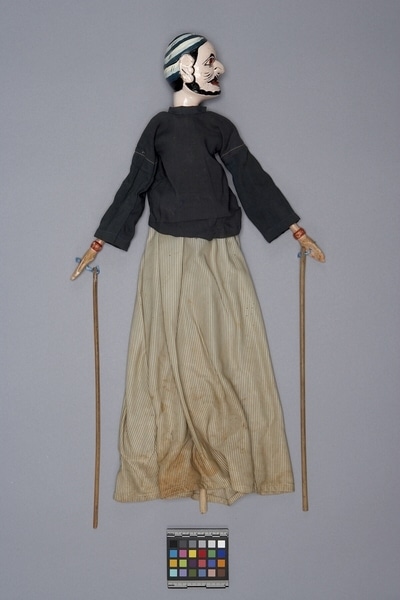Rod Puppet Item Number: Ib280 a-c from the MOA: University of British Columbia


Description
Three-dimensional carved wooden hand puppet with sticks for manipulation of the arms. Wooden upper body (part a) extends to a handle beneath puppets lower garments; sticks joined to hands with blue twine. Painted pink face (part b) with large eyes with red irises; red closed lips; large ears; a thinly scalloped black beard painted and extending from the ears across the lower face line and chin. Also has a small painted black moustache. Head wrapped in a spiraling wound turban of dark blue, light blue, and white; short black hair beneath it. Figure wears a square black tunic with long sleeves over a long skirt, beige with black stripes and rust stained lower portion. Both garments of polyester. Jointed arms painted pink with red bulbs at wrists; paint on hands worn. Pointed (part c) controlling rod is tapered at the end.
History Of Use
Javanese puppetry as an art form probably developed by the 11th century. The three-dimensional wooden wayang golek puppets of western Java, which are to be distinguished from the earlier and more sacred wayang kulit shadow plays puppets or other forms, appeared during the 16th century. Originally the plays depicted Javanese mythology, but after the Indian conquest of Java the Hindu epics, Ramayana and Mahabharata, were incorporated into the cycles, which comprise about 200 plays. An individual or group hires a dalang (puppet-master) to celebrate important occasions. The performances often last all night and are generally presented in three acts, with vocal and instrumental accompaniment. The individual plays vary widely in detail but usually involve conflict between good and evil. They serve a moral and religious purpose, and more recently, one of political commentary. Each puppet's character is represented by its appearance and placement onstage; protagonists with strong elements of good are placed to the right, antagonists of violent or evil nature to the left. Kartamrama is one of the most important aggressors against the Pandawas in the extremely popular and commonly performed Mahabharata cycle, which is concerned mainly with the conflict between good and evil in the form of, respectively, the brothers Pandawa and Kurawa. Kartamarma is involved with many of the plays of this cycle; but the Pandawas are almost exclusively the victors in the conflict. Each side attempts to enlist the aid of the gods, but the evil Kurawas are often allied with the ogres, which were introduced into the cycles by the Indonesians from their own mythological past. The ogres provide a clear example of evil in the plays, where even the most evil Kurawa or the purest Pandawa has some opposing traits.
Cultural Context
Theatrical performance.
Iconographic Meaning
Puppet has several features of evil disposition, but is not entirely so. Pink face indicates vindictiveness, cruel nature, ruthlessness, and greed; shape of face associated with the Kurawa family, facial features also less than refined. However, garments and dress present a character of wealth and rank: turban or songkok suggests divine nature. Puppet represents Kartamarma, one of the commanders of the Kurawa brothers, chief antagonists in the Mahabharata cycle in their conflict with the good Pandawa brothers.
Item History
- Made in Java, Indonesia
- Owned by Tradewind Antiques before March 15, 1983
- Received from Museum of Anthropology Shop Volunteers (Funding source) and Tradewind Antiques (Seller) on March 15, 1983
What
- Name
- Rod Puppet
- Identification Number
- Ib280 a-c
- Type of Item
- puppet
- Material
- wood, paint and synthetic fibre
- Manufacturing Technique
- carved, painted, machine woven, sewn and tied
- Part A
- height 55.0 cm, width 19.6 cm, depth 7.0 cm
- Part B
- height 12.0 cm, width 7.0 cm, depth 8.2 cm
- Part C
- height 32.5 cm, width 3.2 cm, depth 1.3 cm
Who
- Culture
- Sundanese
- Previous Owner
- Tradewind Antiques
- Received from
- Museum of Anthropology Shop Volunteers (Funding source) and Tradewind Antiques (Seller)
Where
- Holding Institution
- MOA: University of British Columbia
- Made in
- Java, Indonesia
When
- Ownership Date
- before March 15, 1983
- Acquisition Date
- on March 15, 1983
Other
- Condition
- good
- Accession Number
- 0886/0014 a-c